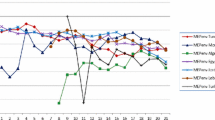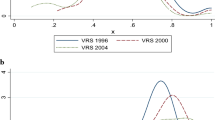Abstract
This paper analyses the production technology of Portuguese banks during the 1992–2006 period through the estimation of a translog cost frontier. This period is of major interest because it covers Portugal’s euro area accession and its impact on the banking system. Hence, critical factors impacting the banking system are identified against the background of increasing financial integration prior to the financial crisis that started in 2007 and later translated into strains in some European sovereign debt markets. Banks are modelled as firms which produce loans and other earning assets, choosing the cost minimizing combination of labour, capital and interest bearing debt, subject to holding a predetermined level of equity. According to the results of this study, technological progress has shifted the cost frontier downwards throughout the period under consideration, whereas the distance at which banks have operated from the frontier seems to have remained constant. Further, increases in production under scale economies have also contributed to the recorded increase in productivity.





Similar content being viewed by others
Notes
Cost inefficiency is commonly referred to in the literature as X-inefficiency.
See Freixas and Rochet (1998), pp. 77–79, on the production and intermediation approach.
The fact that the production approach identifies as outputs the number of loans originated and deposit accounts constitutes an additional complication since this data is often unavailable. Studies which follow the production approach usually circumvent this issue by proxying the number of loans and deposit accounts by their value.
As argued in the Introduction, the covered period includes the extremely important preparation for and pre-crisis membership of the euro area and it excludes data from 2007 due to the perturbations related to the financial crisis.
Similarly to other papers, such as Fiorentino et al. (2006), Fries and Taci (2005) and Lang and Welzel (1996), the cost function was estimated using nominal data. Nonetheless, as a robustness check, the model was also estimated using deflated data and the results (not shown but available upon request) were broadly unchanged.
Securitization in Portugal began in 1997 and grew rapidly in recent years, accounting for around 6 % of aggregate loans outstanding in 2004. Nonetheless, some heterogeneity was present among banks, with a particular bank presenting a share of securitized loans as high as 34 % on a non-consolidated basis in 2004.
The full estimation results are available from the authors upon request.
The measure of implicit interest rate used is computed based on interest income and loan stocks which do not include non-performing loans. Hence, it is a proxy for the interest rate that banks charge their costumers, which should be higher than the average interest rate that they actually receive due to loan delinquency. Hence, the decrease in non-performing loans observed throughout the sample period should also have contributed to the observed decrease in banks’ price-cost margin. Nonetheless, constructing a measure of interest rate which is a lower bound for the one that banks actually receive, since it includes non-performing loans but not the interest on these loans, the decreasing pattern found for the margin on loans is still present. Hence, this behaviour was not solely driven by the decrease in loan delinquency observed throughout the sample period.
One must bear in mind the limitations of the model employed, by operating under the framework of a static optimization model estimated using non-consolidated accounting data.
The fact that the dependent variable of this regression is itself an estimate means that the standard errors of this regression are not valid, since they do not account for the variance of the dependent variable.
The fact that the aggregate value of the cost efficiency estimate is not constant even though each bank’s efficiency estimate is time invariant is motivated by a composition effect. In fact, due to changes in banks’ market shares, the weights used in aggregation (the value of granted loans) are not constant and, due to mergers/acquisitions and to the emergence of new banks, estimation relies on an unbalanced panel of data.
Note that this measure underestimates technological progress when the quality/variety of products increases through time.
References
Antão P, Boucinha M, Farinha L, Lacerda A, Leal AC, Ribeiro N (2009) Financial integration, financial structures and the decisions of households and firms. In: de Portugal B (ed) The Portuguese economy in the context of economic, financial and monetary integration. Economics and Research Department, Banco de Portugal, pp 415–545
Battese GE, Coelli TJ (1992) Frontier production functions, technical efficiency and panel data: With application to paddy farmers in india. J Prod Anal 3:153–159
Battese GE, Coelli TJ (1995) A model for technical inefficiency effects in a stochastic frontier production function for panel data. Empir Econ 20:325–332
Bauer PW (1990) Decomposing tfp growth in the presence of cost inefficiency, nonconstant returns to scale, and technological progress. J Prod Anal 1:287–299
Berger AN, Mester L (1997) Inside the black box: what explains differences in the efficiencies of financial institutions. J Banking Finance 21:895–947
Boucinha M, Ribeiro N (2009) An assessment of competition in the Portuguese banking system in the 1991–2004 period. Working paper 1, Banco de Portugal
Canhoto A, Dermine J (2003) A note on banking efficiency in Portugal, new vs. old banks. J Banking Finance 27:2087–2098
Fiorentino E, Karmann A, Koetter M (2006) The cost efficiency of German banks: a comparison of SFA and DEA. Discussion paper series 2: Banking and Financial Studies 10/2006, Deutsche Bundesbank
Freixas X, Rochet JC (1998) Microeconomics of banking. MIT Press, Cambridge
Fries S, Taci A (2005) Cost efficiency of banks in transition: evidence from 289 banks in 15 post-communist countries. J Banking Finance 25:55–81
Hughes JP (1999) Incorporating risk into the analysis of production. Atl Econ J 27(1):1–23
Hughes JP, Mester LJ (1993) Accounting for the demand for financial capital and risk-taking in bank cost functions. Working paper 93–17, Federal Reserve Bank of Philadelphia
Hughes JP, Mester LJ, Moon CG (2001) Are scale economies in banking elusive or illusive? evidence obtained by incorporating capital structure and risk-taking into models of bank production. J Banking Finance 25(12):2169–2208
Lang G, Welzel P (1996) Efficiency and technical progress in banking: empirical results for a panel of German cooperative banks. J Banking Finance 20:1003–1023
Lima F (2008) Product differentiation and the measurement of cost efficiency in banking: the case of Portuguese banks. In: Soares J, Pina J, Catalão-Lopes M (eds.) New developments in financial modelling. Cambridge Scholars Publishing, Cambridge, pp 34–76
Lima F, Pinho PS (2008) Financial disintermediation and the measurement of efficiency in banking: the case of Portuguese banks. Int J Banking Account Finance 1(2):133–148
Mendes V, Rebelo J (1999) Productive efficiency, technological change and productivity in Portuguese banking. Appl Financial Econ 9:513–521
Mendes V, Rebelo J (2000) The effect of bank M&As on efficiency: the Portuguese experience. In: Abreu M, Mendes V (eds) What financial system for year 2000? Principia Academic Press, Lisbon, pp 287–293
Pinho PS (2001) Using accounting data to measure efficiency in banking: an application to Portugal. Appl Financial Econ 11:527–538
Ribeiro N (2007) Debt growth: factors, institutional issues and implications—the Portuguese case. In: Enoch C, Ötker Robe I (eds) Rapid credit growth in central and eastern Europe: endless boom or early warning? Palgrave MacMillan and IMF, Basingstoke, pp 296–311
Sealey C, Lindley J (1977) Inputs, outputs and a theory of production and cost at depository financial institutions. J Finance 32(4):1251–1266
Acknowledgments
We are grateful to Diana Bonfim for helpful comments and suggestions provided since early stages of this work. Comments and suggestions provided by Mário Centeno, Filipa Lima, Pedro Pita Barros and seminar participants at the EWG-EPA 2010 Conference are also gratefully acknowledged. Any errors or omissions remain our own.
Author information
Authors and Affiliations
Corresponding author
Additional information
The analyses, opinions and findings of this paper represent the views of the authors, which do not necessarily reflect those of Banco de Portugal
Rights and permissions
About this article
Cite this article
Boucinha, M., Ribeiro, N. & Weyman-Jones, T. An assessment of Portuguese banks’ efficiency and productivity towards euro area participation. J Prod Anal 39, 177–190 (2013). https://doi.org/10.1007/s11123-012-0310-2
Published:
Issue Date:
DOI: https://doi.org/10.1007/s11123-012-0310-2




